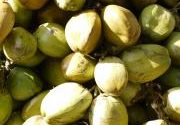Nordic microalgae cleans wastewater and produces biodiesel
Lorenza Ferro demonstrates the potential of Nordic microalgae to produce both biomass and municipal wastewater in the Nordic climate. She also studied how microalgae and bacteria work synergistically and how it affects the composition of microbial communities in open algae cultures. She defended her thesis at Umeå University on Friday, March 15.
Green microalgae transforms photosynthetic water organisms 2 into energy and biomass using a small number of nutrients such as sunlight. Algal biomass is considered a good source of biofuels because these microorganisms naturally form and store large amounts of lipids, which in turn can be converted to biodiesel. In addition, nitrogen and phosphorus found in municipal wastewater can be recycled for feeding microalgae, which means the same process can be used for biomass production and wastewater treatment.
However, in the northern countries, the use of microalgae is very limited, and the long winter is characterized by hours of daylight and low temperature limiting growth. In her paper, Lorenza Ferro showed that using native Nordic algae strains, these strains naturally adapt to the harsh environmental conditions of these parts and can be a successful solution for microalgae farming in the region.
Several Swedish microalgae strains capable of growing in municipal wastewater were isolated and genetically classified. Eight strains were characterized on a laboratory scale to remove excess nutrients from wastewater very effectively; four showed signs of rapid growth, high biomass production and lipid content; three of which also demonstrated effective adaptation Low temperature or limited light conditions.
In her project, Lorenza Ferro also studied whether algae and bacteria can benefit each other in wastewater treatment, ie whether the Nordic microalgae strain interacts with bacteria in the culture.
“We observed a positive impact on biomass production and nutrient removal under certain agricultural conditions.”
In a pilot study, she used a DNA-based method called metabarcoding to study seasonal changes in algae ponds in Dåva (10 km from Umeå), which was inoculated with microalgae control strains in 2015 (ie not From our Nordic collection), allowing growth from May to early November. The results showed that the original microalgae were competitive by other algae and zooplankton, resulting in reduced biomass and reduced nitrogen and phosphorus, especially in the late growing season.
“My work shows once again that the local Nordic microalgae is much better than the standard strain. Our Nordic strains are currently being tested under “real conditions” in order to extend the growing season until late autumn and even winter.


